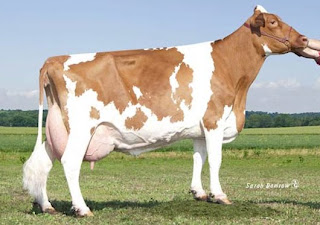Hoard Jerseys see the appraiser
 Earlier this month, the Hoard Jersey herd which now numbers 101 cows (plus 11 heifers) was appraised by AJCA appraiser, Blake Renner. We purchased the Jerseys from three Wisconsin herds, and they are housed in our old tie stall barn that recently made a complete transformation into a free stall facility. The barn is scraped twice a day with a skid loader, and cows are fed outside with drive-by feeding. The Jerseys make their way to our three-year-old parlor three times a day to get milked.
Earlier this month, the Hoard Jersey herd which now numbers 101 cows (plus 11 heifers) was appraised by AJCA appraiser, Blake Renner. We purchased the Jerseys from three Wisconsin herds, and they are housed in our old tie stall barn that recently made a complete transformation into a free stall facility. The barn is scraped twice a day with a skid loader, and cows are fed outside with drive-by feeding. The Jerseys make their way to our three-year-old parlor three times a day to get milked.When we were done, the American Jersey Cattle Association put scores on 50 head. The entire group averaging just shy of two lactations averaged 80.3 points which is down one-tenth of a point from our December score. That average included the 50 cows that previously were scored in the current lactation and did not change in score. When looking at the herd by lactation number, we had:
• 22 first-lactation (first-score cows) averaged 78.2 points
• All 36 first-lactation cows that averaged 78.7 points
• 41 second-lactation cows that averaged 80.8 points
• 23 third-lactation cows and greater that averaged 82 points
Overall, the second-lactation group was one point higher compared to last December. And that was with 22 more cows in the group. Our second-lactation average scores is right at breed average.
For those who follow the Hoard Farm Guernseys: Numbers are near an all-time high. We have 333 Guernsey cows and 292 Guernsey heifers, of which 95 are safe in calf, 67 are unbred yearlings, and there are 141 calves.
Labels: appraisal, Hoard Farm, Jersey






